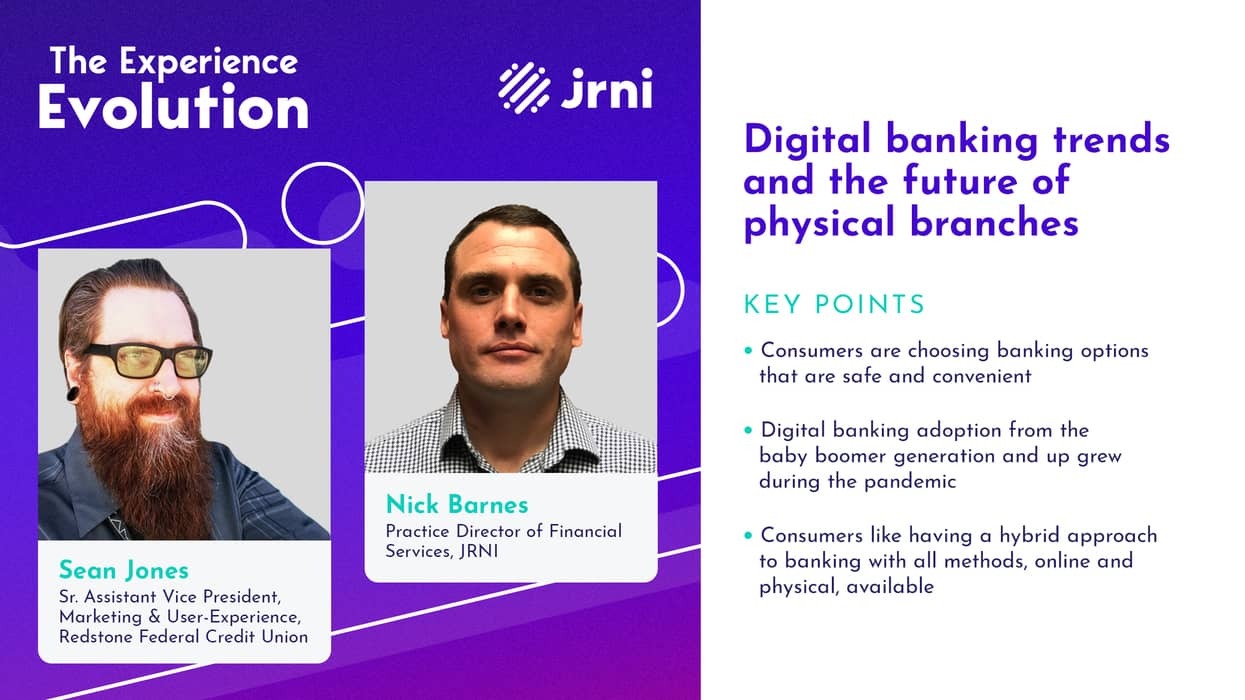As the pandemic accelerated the adoption of digital banking across demographics, the role of physical branches started to evolve rapidly as well. With safety becoming a top priority for customers due to the Delta variant, there is more to balance than ever when it comes to meeting customer needs.
In this episode of The Experience Evolution podcast, Nick Barnes, Practice Director for Financial Services at JRNI, and Sean Jones, Sr. Assistant Vice President, Marketing & User-Experience at Redstone Federal Credit Union, share insights on current banking trends. How is digital banking changing, and what is the future of physical branches?

Key takeaways:
Consumers are choosing banking options that are safe and convenient
Digital banking adoption from the baby boomer generation and up grew during the pandemic
Consumers like having a hybrid approach to banking with all methods, online and physical, available
Digital banking continues to rise
As digital banking services accelerated across the industry, Jones said that Redstone Federal Credit Union members were looking for ways to bank from the comfort of their homes or in a remote fashion. Additionally, Redstone has seen increases in other types of services that don’t require members to go into a physical branch.
“We've seen a fairly significant increase in the use of ATMs, which are our interactive teller machines, that allow members to do their banking without needing to come into a branch. And then obviously, there's been a significant explosion of the volume of mobile banking and digital banking that's taking place,” Jones said.
Barnes agrees that due to safety and health concerns, more members and customers are continuing to embrace remote ways of banking, including video appointments.
“It seems like everyone across every demographic is comfortable with [video appointments]. And often, people prefer it. A recent study from Vonage shows that globally consumers are now using video calls to communicate with businesses 67% more than they were a year ago. And so from a banking perspective, video appointments mean that the customers or members can avoid the hassle of drive time and waiting in queues,” Barnes said.
Physical branches are here to stay
While the conversation around physical branches has been ongoing long before the pandemic, many wonder what role branches play in today’s world now that digital solutions have been widely adopted.
Regardless of the necessity of digital services throughout the pandemic, many members and customers still prefer to bank in person, especially for certain transactions. Barnes said that recent research on hybrid banking shows that loans are the number one reason why customers want to meet in a branch.
“Research shows that 45% of bank customers would prefer meeting with an agent in person. And the top reasons for that is wanting to discuss mortgages, home equity loans, small business loans, and commercial real estate loans,” Barnes said. “And this shows that even though a lot of this can be done online now, people still value in-person connections. They want to be able to physically sit down with an expert to discuss options.”
Jones agrees, stating that many members have certain services where they prefer to sit down with an expert.
“I think you're always going to have certain services that individuals are going to find comfort in talking to an individual [in person],” Jones said.
While determining the best way to balance digital banking and physical branches, Barnes also notes that banks and credit unions should evaluate branch performance from an operational standpoint.
“It’s also about evaluating performance across branches, and ensuring a cohesive experience across online and digital channels. What were your top performing or most trafficked branches? What services need to be provided and what languages need to be spoken? You want to accommodate the needs of your customers as much as possible, and remain operationally efficient,” Barnes said.
Consumers want more efficient ways to bank
Additional changes in consumer behavior point to efficiency as an important factor. Jones said this is especially true when coming into the branch, which is why they’ve seen an increase in appointment scheduling, to ensure they have a set time to speak with an expert.
“So behaviorally, one of the things that was a significant change for us was the wider adoption of appointment setting. What we're seeing is that if individuals choose to come into the branch, they're definitely doing it in a more streamlined fashion, they want to come in, take care of their business and move on with the day.”
Sean Jones, Sr. Assistant Vice President, Marketing & User-Experience at Redstone Federal Credit Union
In addition to efficient and convenient services, Barnes said that customers and members are also looking for personalization, with recent research showing that 69% of bank customers have considered switching banks because they couldn't get personalized service.
“I cannot emphasize enough how important that personalization is in today's world,” Barnes said. “If you aren't providing personalized service, both online and in branch, and engaging your banking customers, they will find another place to bank.”
Subscribe to The Experience Evolution today!
Want to be updated when our next podcast episode is available? Then be sure to subscribe on Apple or Spotify! You can download the episodes and listen at your convenience. Additionally, you can find all future podcast episodes on our podcast page. If you are looking to provide better customer experiences through appointment scheduling, then sign up to speak to one of our experts!



